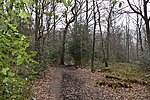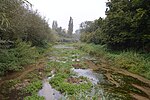Barn Theatre, Welwyn Garden City
Barn theatresGrade II listed barnsGrade II listed buildings in HertfordshireTheatres in HertfordshireWelwyn Garden City
The Barn Theatre, located in Welwyn Garden City, England is a Grade II listed, 17th-century timber-framed barn converted to a community theatre in 1931. It is owned by The Barn Theatre Trust and used by a local amateur theatre company, The Barn Theatre Club. It has two performance spaces: a main auditorium and a studio.
Excerpt from the Wikipedia article Barn Theatre, Welwyn Garden City (License: CC BY-SA 3.0, Authors).Barn Theatre, Welwyn Garden City
Barn Close, Welwyn Hatfield Handside
Geographical coordinates (GPS) Address Nearby Places Show on map
Geographical coordinates (GPS)
| Latitude | Longitude |
|---|---|
| N 51.7984 ° | E -0.215 ° |
Address
The Barn Theatre
Barn Close
AL8 6ST Welwyn Hatfield, Handside
England, United Kingdom
Open on Google Maps









